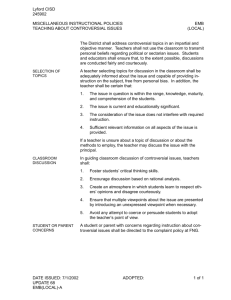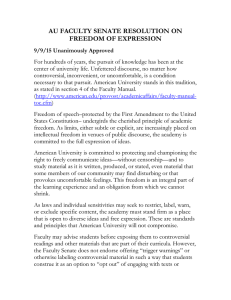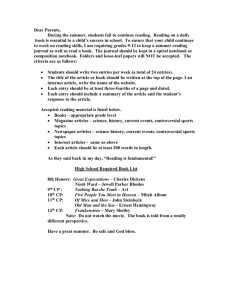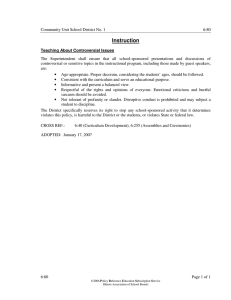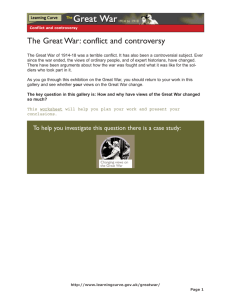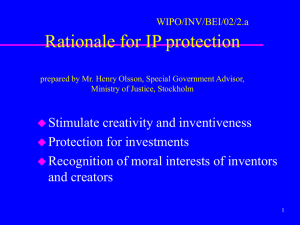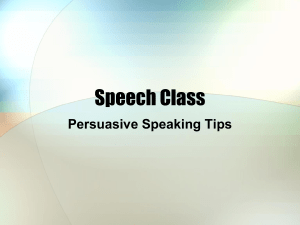Controversial Issues and Democracy Why address controversial issues?
advertisement
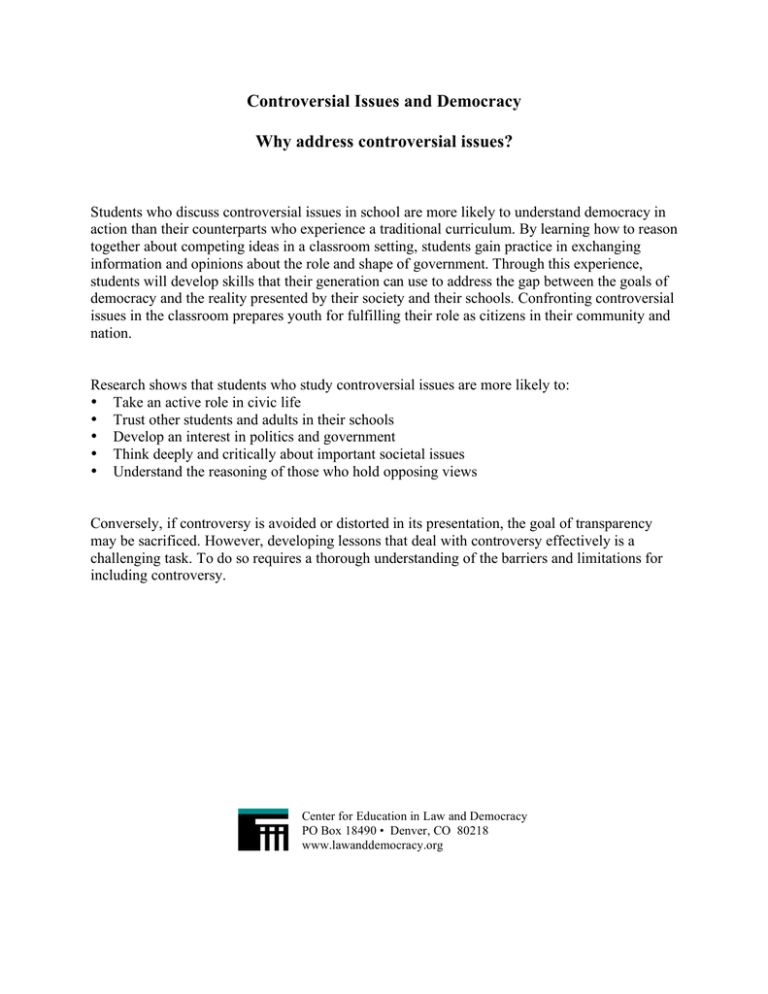
Controversial Issues and Democracy Why address controversial issues? Students who discuss controversial issues in school are more likely to understand democracy in action than their counterparts who experience a traditional curriculum. By learning how to reason together about competing ideas in a classroom setting, students gain practice in exchanging information and opinions about the role and shape of government. Through this experience, students will develop skills that their generation can use to address the gap between the goals of democracy and the reality presented by their society and their schools. Confronting controversial issues in the classroom prepares youth for fulfilling their role as citizens in their community and nation. Research shows that students who study controversial issues are more likely to: • Take an active role in civic life • Trust other students and adults in their schools • Develop an interest in politics and government • Think deeply and critically about important societal issues • Understand the reasoning of those who hold opposing views Conversely, if controversy is avoided or distorted in its presentation, the goal of transparency may be sacrificed. However, developing lessons that deal with controversy effectively is a challenging task. To do so requires a thorough understanding of the barriers and limitations for including controversy. Center for Education in Law and Democracy PO Box 18490 • Denver, CO 80218 www.lawanddemocracy.org CONTROVERSIAL ISSUES AND DEMOCRACY CRITERIA FOR SELECTING ISSUES 1. Is a balanced debate on the issue possible? 2. Is the issue really controversial? 3. Is the issue important to the development of democracy/rule of law? 4. Do youth view this as an important issue? 5. Is this issue appropriate for the youth in this community/class? Center for Education in Law and Democracy PO Box 18490 • Denver, CO 80218 www.lawanddemocracy.org Substantive criteria for selecting the content of controversial issues Many of the challenges that arise when teaching controversial issues can be avoided through the process of carefully selecting issues and developing materials that meet the criteria listed below: 1. Is a balanced debate on the issue possible? Will arguments on both sides be given “a best case, fair hearing”? When undertaking a controversial issue discussion, teachers must determine whether or not multiple perspectives exist. Can reasonable arguments be formed to reflec opposing viewpoints? Do the materials provide a balanced presentation of the issue? A test of whether or not you can successfully meet this standard is to ask if proponents from each side were listening in on your class discussion, would they find that the most compelling arguments for their position were presented. 2. Is the issue really controversial? Framing an issue so that it contains an appropriate amount of controversy can be challenging. Some issues of right and wrong should be taught as such rather than as an issue to be debated. For example, whether or not citizens should have access to basic human rights should not be selected as a controversial issue. All citizens should have such rights. For example, slavery is not controversial; it is wrong. However, slavery can be presented as a controversial issue if the question is framed as how to correct a wrong. A teacher in the U.S. might frame a controversial issue regarding payment of reparations to the descendents of slaves. However, a teacher would not want to ask, “Should we make slavery legal again?” Topics such as slavery need to be addressed in their historical context. 3. Is the issue important to the development of democracy/rule of law? Does the issue illuminate important democratic values that are in conflict? Will addressing this issue result in the development of a more open society? Democratic societies often confront situations in which important democratic values are in conflict. For example, hate speech represents a conflict between a right to freedom of expression and tolerance for people and ideas different from your own. Debating the best way to accommodate competing values through a current issue is an important citizen activity. For example, many controversial issues in emerging democracies involve tension between the rights of an individual and the common good of the whole society. 4. Do youth view this as an important issue? Youth look at issues differently than their teachers. When possible, it is important to involve them in selecting issues that they want to study. Start by finding out what the students already know and believe. Design a selection process that involves them. Have students vote to select topics from a list you have designed or ask them to propose topics for future discussion by bringing newspaper articles and political cartoons. 5. Is this issue appropriate for the youth in this community/class? Some issues may meet all criteria listed above but still not be suitable for the classroom because the community or the class as a whole is too emotionally involved in the issue. What if students all gravitate to the same viewpoint? What if personal conflicts erupt that might carry beyond the classroom? If the teacher feels that the ideas and reasoning of all students will not receive “a balanced best case, fair hearing” in the classroom or the community, the issue should be passed over as a controversial issue. Perhaps some other strategy can be selected to present the issue. DISCUSSING CONTROVERSIAL ISSUES: DISCUSSION MODELS http://www.lawanddemocracy.org/discussionmain.html In conversations with opinion makers and educators in Colorado, CELD staff found widespread support for improving discussion of controversial issues in our state’s classrooms. Teachers want young people to be engaged in deliberation on important issues because the ability to take part in civil discussions of controversial matters is essential to citizenship in democracy. We also recognize the need to provide teachers with high quality professional development and materials that will assist them in their efforts. This web module is a first effort to address the need for materials and professional development electronically. The module provides a variety of tools that can be used by individual teachers or by educators planning professional development focused on discussing controversial issues. 1. Structured Academic Controversy http://www.lawanddemocracy.org/discussionsac.html This model developed by the cooperative learning gurus Roger and David Johnson is a small group (four-person) model in which four-person groups try to reach consensus on some aspect of an issue. Structured academic controversy is designed to help students achieve three goals: (1) to gain a deeper understanding of an issue, (2) to find common ground, and (3) to make a decision based on evidence and logic. Discussion in the SAC model focuses on policy questions, such as: Should the state of Colorado increase the driving age to 18? or Should the United States continue to use a policy of pre-emptive strikes against countries that pose an “eminent threat”? To use the SAC model, teachers need grade-level appropriate background material on the selected issue; the background material should provide facts about the issue, as well as arguments favoring opposing views on the issue. 2. Public Issues Model http://www.lawanddemocracy.org/discussionpi.html This model, developed at Harvard in the 1960s, teaches students to identify the types of issues (definitional, fact-explanation, and values) about which there is disagreement. Once the type of issue has been identified, different strategies can be applied for resolving the issues and/or moving discussion forward. In the public issues model, the purpose of discussion is not to resolve disagreements—although that can be an outcome—but to help students learn to state their ideas with more precision, to develop stronger rationales for their positions, and to understand precisely how their ideas differ from those of others. As with other models, students must come to the discussion with knowledge of the issue at hand. Thus, preparation in this model involves not only learning the skills of Public Issues discussion but also gathering background information (often presented through specific cases that represent the issue at hand) and examining strong examples of arguments that support various positions on the issue. This information can be presented in a range of ways—through mini-lectures, whole-class reading and comprehension activities, jigsaw strategies—the possibilities are numerous and can be supplemented by additional student research. 3. Civil Conversation http://www.lawanddemocracy.org/discussioncivil.html The civil conversation model developed by the Constitutional Rights Foundation, like a Socratic seminar, engages students in close analysis of a text (note that text is broadly interpreted, since a visual or piece of music can serve as the text on which a conversation is based). The conversation takes place with the students in a circle. The teacher acts as a facilitator. In using the civil conversation model, choosing the text is a key step in preparing for the discussion. The text should not be too long but should include provocative ideas that will spark conversation. As students read the text, they complete a reading guide, which serves as a “ticket” into the conversation. The guide requires them to (1) identify the topic and main points in the text, (2) list what they agree and disagree with in the text, and (3) pose questions about the text they believe are worthy of discussion. Students are likely to need some coaching on what makes a good discussion question, as they are initially likely to pose factual questions that ask for additional information about the subject of the article. While these questions can be good spurs to additional research, they are not successful discussion questions. Good discussion questions ask students to think about an issue, to take a position and to back it with evidence. 4. Philosophical Chairs Discussion http://www.lawanddemocracy.org/discussion.philos.html This model includes a movement component, which can be particularly beneficial to some students who are kinesthetic learners. Students prepare for the discussion by reading material on an issue and deciding which position they will take; alternatively, the teacher can assign positions. The chairs in the classroom are arranged in a U shape. Students at the bottom of the U are those who are neutral or undecided. Students on opposing sides of the issue sit across from each other. Students can move at any time during the discussion (in fact, they are encouraged to do so). A student on one side of the issue begins by explaining why he/she is taking the pro or con position. A student on the other side then briefly summarizes the previous speaker’s point before beginning his/her comments. The discussion continues with students on the two sides taking turns speaking, always summarizing the previous speaker’s point before providing their own comments. After a student speaks, he/she must wait until two students on his/her side have spoken before speaking again (this number could be raised if necessary to keep students from dominating). The teacher can call time-out to clarify, reflect on the process or content, or refocus students. Students in the neutral zone must take notes on both sides of the argument and can ask questions of students on either side. When students move, they should be able to explain why their views changed. At the end of the discussion, one student from each team summarizes the viewpoints presented by that team during the discussion. Students in the neutral zone must then report on whether any of the arguments they heard have caused them to take a position on the issue. Center for Education in Law and Democracy PO Box 18490 • Denver, CO 80218 www.lawanddemocracy.org
